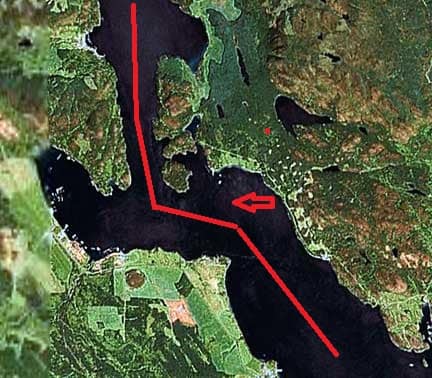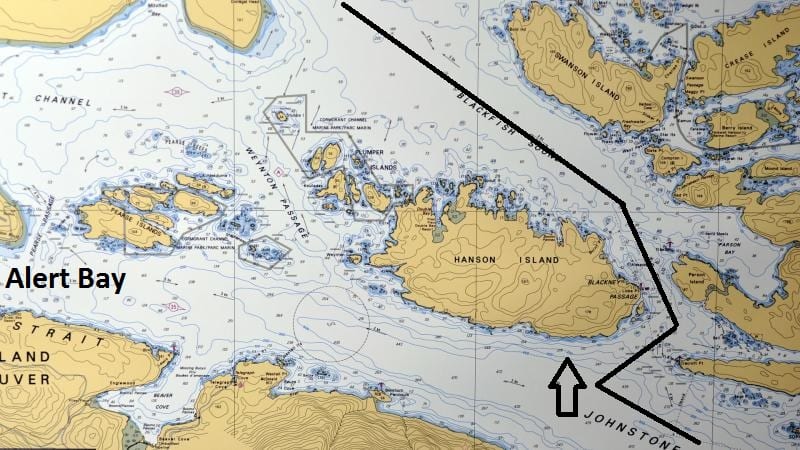
Seymour Narrows. The challenge is this big course change right in the area where the current creates eddies and does not follow the regular direction of the channel.
The weather is still not helping and this morning I really thought that I was walking around in a Tolkien book with Misty Mountains all around me. The captain did not have an easy night as by 22.30 visibility went down to zero and that lasted until 3 am in the morning after which it marginally improved. This was also the period when we went through Seymour Narrows and Race Passage; areas we prefer to go through when we can see something. Although we can do it safely on the radar, especially if you have been there before and know what is looks like in reality. You can super impose your own memory on top of the radar picture and build yourself a sort of 3D picture of what the situation is really like.

Blackney Passage. Again the challenge is the way the current will affect the ship due to the big course change. When the weather is nice and we have the time we sail past Alert Bay, but it is a much longer and slower route. So only worthwhile to do when we have guests on the outside decks.
From Race Passage the route took us through Blackney Passage. On the way back to Vancouver we pass this area in daylight and at a half decent time for the guests to be up and about. We then also have the option to sail past Alert Bay, but that takes more time due to the longer period of slow speed required. In the very early morning we might as well take the fast route as there is nobody around yet to enjoy the scenery, or the Orcas who show up here very frequently. Blackney Passage is also an area which requires a bit more focus and then we normally have the Staff Captain on the bridge as an extra pair of eyes, while the Pilot assisted by the Bridge Team keeps conning the vessel. The currents in Blackney seldom reach more than 4 knots but the challenge here is that it includes a more than 90o turn, going from a wide open area (Johnstone Strait) into a small hole (Blackney Passage) to reach Blackfish Sound. While doing that the current which is normally with you or against you, is pushing the ship all over the place if we are not careful.
After Blackney there are several ways to go up to Triple Island where the pilot station for the B.C pilots is located. We can go all the way outside, we can go all the way inside or we can do a combination. That depends mainly on how much time we have, what the captain prefers and what the weather is going to be like. Today the weather was lousy with nothing to see so the captain opted for sailing through Queen Charlotte Sound and then try for Grenville Channel. That is a very scenic route and often if the weather is miserable in the more open area’s the high mountains on either side of Grenville, tend to create a sort of Micro Climate.
When we got there is was marginally better, but still the weather remained damp and gloomy. However now the mountains are so close by that regardless of the rain you still get a very good impression of the awesomeness of the nature here. Grenville Channel has one challenge and that is traffic. There is not much of it, but if there is, then it normally affects you. Also this time; one southbound vessel which we would have exactly met in the most narrow part of the channel at Tom Island. Thus we had to slow down to wait until that ship cleared the narrow gap before we could go through. Tom Island is as far as I know named after a gentleman called tom who lived around the corner and operated a small Salmon Canning factory.
From Tom Island it was another three hours before we got to the Triple Island pilot station where we said goodbye to our two Canadian Pilots. From now on we are on our own until tomorrow morning at 04.30 when we will embark the Alaskan pilot at Twin Island which is about 20 miles to the East of Ketchikan. Only one pilot will come on board as it is only a short stretch to sail. The 2nd pilot will then simply walk on board in Ketchikan so we will have two pilots on board until after Glacier Bay.
Weather for tomorrow. More of the same 49of / 9oC overcast with a 55% chance of rain. I wonder what is happening to the summer here…………………

June 20, 2017 at 10:49 pm
Captain Albert,
Thanks for all of the comments regarding the navigational challenges sailing to/from Vancouver up the inside passage. We just sailed it on the Volendam when it repositioned from Asia a little over a month ago. Those 90 degree turns are impressive.
Tim Bowman